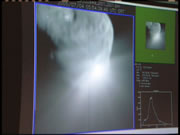 Got it! The view from Deep Impact 13 seconds after collision. Click here to see more images.© NASA
Got it! The view from Deep Impact 13 seconds after collision. Click here to see more images.© NASAIn a triumph of cosmic marksmanship, a NASA probe has smashed into Tempel 1, releasing a spray of ancient debris from the comet's core.
The spacecraft Deep Impact released a copper-reinforced probe, which was the size of a washing machine and weighed a third of a tonne, on 3 July. The probe was travelling at 37,000 kilometres per hour when it smashed into the comet at about 05:52 GMT on 4 July. Deep Impact watched the crash from a safe distance.
"The impactor has been totally vaporized," says Rick Grammier, mission manager at the Jet Propulsion Laboratory in Pasadena, California. "We were right on target."
Scientists hope that the shape of the crater will reveal the strength of the comet's crust, and that the debris thrown outwards will hold clues about the characteristics of the early Solar System.
Comets are dirty snowballs, left over from the formation of the planets some 4.6 billion years ago. They probably delivered water and simple carbon molecules to the primitive Earth, shaping the chemistry that ultimately led to life on our planet. But very little is known about their internal composition and structure.
Analysing pristine material from inside Temple 1 will be like stepping back in time, says Andrew Coates of the Mullard Space Science Laboratory at University College London, who watched the first images arrive at a press briefing in London. "It's one of the most audacious experiments ever attempted," he says.
Bigger blast
 Read Mark Peplow's diary blog entry from the Deep Impact press briefing.
Read Mark Peplow's diary blog entry from the Deep Impact press briefing.Deep Impact watched the show for about 13 minutes before battening down its hatches to avoid flying debris. The craft is sending its analysis of the chemical composition of the plume back to Earth during the following 24 hours. But the shape and brightness of the cone of ejected material is already giving scientists clues about the structure of the Tempel 1 core, which is about 4 kilometres wide and 14 kilometres long.
"A large amount of material has been ejected; far more than people anticipated," says Paul Roche, an astronomer from University of Wales, Cardiff. Roche works on the Faulkes Telescope in Hawaii, which captured images of the collision. The large plume suggests that the comet's crust is weaker than expected, explains Coates, and this improves our chances of seeing material that has lain inside Tempel 1 since it first formed.
"Presumably we have a very large crater," agrees Michael A'Hearn, the mission's principle investigator from the University of Maryland, College Park. A'Hearn estimates that the hole could be the size of a football stadium.
More information is flooding in from observatories around the world and in space, in what some are calling the largest astronomical effort in history.
Tiny nudge
ADVERTISEMENT
The US$330-million Deep Impact mission was launched on 12 January 2005. Once it had the comet in its sights, the impactor probe used a self-targeting mechanism to aim at the brightest spot on the comet, now roughly 134 million kilometres away from Earth. Its camera recorded the fatal dive until just three seconds before impact. From up close, the camera recorded the craters left by previous meteorite collisions.
The impact delivered the same force as about 5 tonnes of TNT, says Roche. But there were never any fears that the comet would be destroyed or pushed towards the Earth, he adds. The impact has nudged the comet so slightly that in 20 years' time it will have strayed only 300 metres from its normal path.
Previous space missions have investigated the surfaces of comets Halley, Borrelly and Wild 2, and the European Space Agency's probe Rosetta hopes to drop a lander on the surface of comet Churyumov-Gerasimenko in May 2014.
